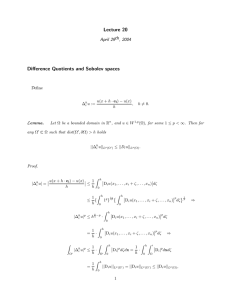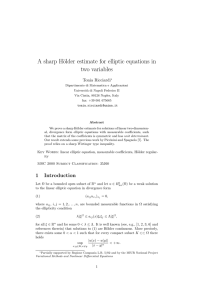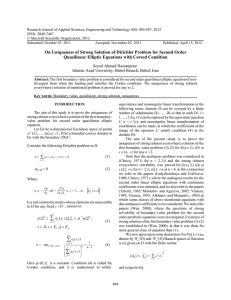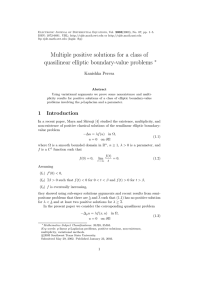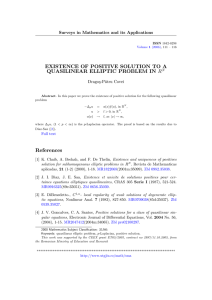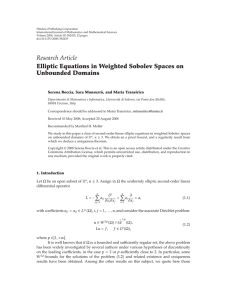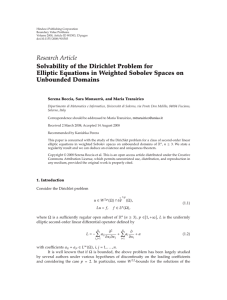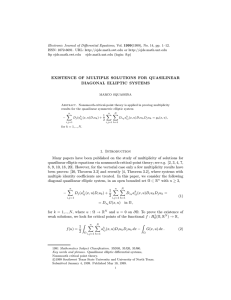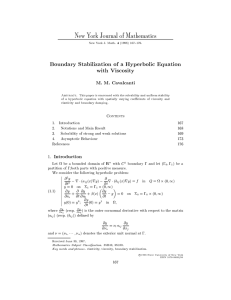Electronic Journal of Differential Equations, Vol. 2009(2009), No. 67, pp.... ISSN: 1072-6691. URL: or
advertisement
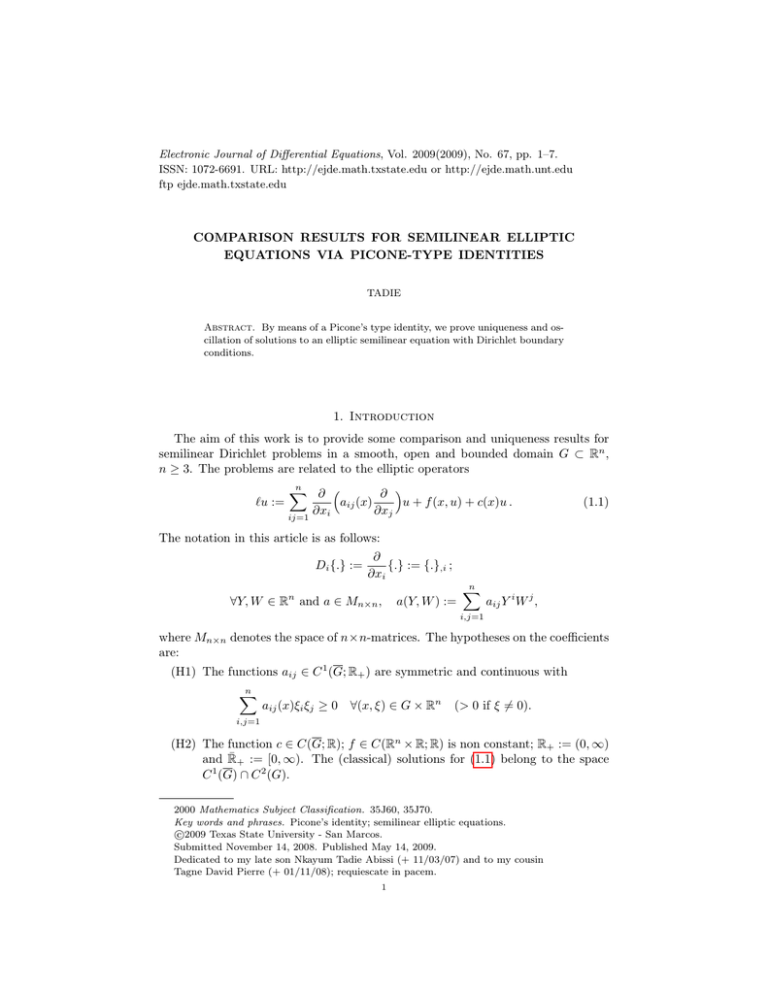
Electronic Journal of Differential Equations, Vol. 2009(2009), No. 67, pp. 1–7.
ISSN: 1072-6691. URL: http://ejde.math.txstate.edu or http://ejde.math.unt.edu
ftp ejde.math.txstate.edu
COMPARISON RESULTS FOR SEMILINEAR ELLIPTIC
EQUATIONS VIA PICONE-TYPE IDENTITIES
TADIE
Abstract. By means of a Picone’s type identity, we prove uniqueness and oscillation of solutions to an elliptic semilinear equation with Dirichlet boundary
conditions.
1. Introduction
The aim of this work is to provide some comparison and uniqueness results for
semilinear Dirichlet problems in a smooth, open and bounded domain G ⊂ Rn ,
n ≥ 3. The problems are related to the elliptic operators
`u :=
n
X
∂ ∂ aij (x)
u + f (x, u) + c(x)u .
∂xi
∂xj
ij=1
(1.1)
The notation in this article is as follows:
∂
Di {.} :=
{.} := {.},i ;
∂xi
∀Y, W ∈ Rn and a ∈ Mn×n ,
a(Y, W ) :=
n
X
aij Y i W j ,
i,j=1
where Mn×n denotes the space of n×n-matrices. The hypotheses on the coefficients
are:
(H1) The functions aij ∈ C 1 (G; R+ ) are symmetric and continuous with
n
X
aij (x)ξi ξj ≥ 0 ∀(x, ξ) ∈ G × Rn
(> 0 if ξ 6= 0).
i,j=1
(H2) The function c ∈ C(G; R); f ∈ C(Rn × R; R) is non constant; R+ := (0, ∞)
and R̄+ := [0, ∞). The (classical) solutions for (1.1) belong to the space
C 1 (G) ∩ C 2 (G).
2000 Mathematics Subject Classification. 35J60, 35J70.
Key words and phrases. Picone’s identity; semilinear elliptic equations.
c
2009
Texas State University - San Marcos.
Submitted November 14, 2008. Published May 14, 2009.
Dedicated to my late son Nkayum Tadie Abissi (+ 11/03/07) and to my cousin
Tagne David Pierre (+ 01/11/08); requiescate in pacem.
1
2
TADIE
EJDE-2009/67
2. Preliminaries
For the (smooth) functions u, w, as in [1], from the expressions Di {uaij Dj u −
(u2 /w)aij Dj w} and u`u we have that if w 6= 0,
n
X
u2
Di uaij (x)Dj u −
aij Dj w
w
i,j=1
(2.1)
u
f (x, w) f (x, u) u u2
= w2 a ∇[ ], ∇[ ] + u`u − `w + u2
−
w
w
w
w
u
and if u 6= 0, then
n
n
o
X
w2
Di waij (x)Dj w −
aij Dj u
u
i,j=1
(2.2)
w
f (x, u) f (x, w) w w2
`u + w2
−
;
= u2 a ∇[ ], ∇[ ] + w`w −
u
u
u
u
w
also for λ 6= 0 if `u = 0, then
`(λu) = f (x, λu) − λf (x, u) .
(2.3)
Remark 2.1. Most of the results will be established by the means of integrating
over G (which is a regular domain) allowing the integration by parts along its
boundary ∂G; this in cases like the left side of say, (2.1) , (2.2) and many other
cases makes the left side of the integral to be zero when u|∂G = 0.
Lemma 2.2. If u1 and w1 are classical solutions of
n
X
`v =
Di aij (x)Dj v + c(x)v = 0 in G ;
v ∂G = 0,
(2.4)
ij=1
then
n
X
n
X
u2
u1
u1
Di u1 aij Dj u1 − 1 aij Dj w1 = w12
aij Di [ ]Dj [ ]
w
w
w
1
1
1
i.j=1
i.j=1
=
(2.5)
u1
u1
w12 a(∇[ ], ∇[ ]) .
w1
w1
The proof of the above lemma follows from the identities (2.1)-(2.2) where f ≡ 0.
Lemma 2.3. If u, v ∈ C 2 with v 6= 0 then
n
u2
X
u
u
Di
aij Dj v
v 2 a(∇[ ], ∇[ ]) +
v
v
v
i,j=1
(2.6)
`v
u2 f (x, v)
= a(∇u, ∇u) + u2 − c(x)u2 −
.
v
v
Proof. As in [6], for all u, v ∈ C 2 with v 6= 0,
2u
u2
u 2
u2
Di aij
Dj v =
aij Di uDj v −
aij Di vDi v + Di (aij vj )
v
v
v
v
and
u u
v 2 aij Di
Dj
v
v
u 2
u
= aij Di uDj u − aij (Di uDj v + Dj uDi v ) +
aij Di vDi v ;
v
v
(2.7)
EJDE-2009/67
COMPARISON RESULTS
3
thus
n n
u2
o
X
u
u
v 2 aij Di
Dj
+ Di
aij Dj v
v
v
v
i,j=1
n
u2
X
u
u
= v 2 a(∇[ ], ∇[ ]) +
aij Dj v
Di
v
v
v
i,j=1
=
n
X
aij Di uDj u +
i,j=1
:= a(∇u, ∇u) + u2
n
u2 X
Di (aij Dj v)
v i,j=1
`v
u2 f (x, v)
− c(x)u2 −
.
v
v
Then (2.6) follows.
n
To ensure that solutions can be extended in the whole R we set the hypothesis
(H3) for all x ∈ Rn and all t ∈ R \ {0}, it holds tf (x, t) > 0.
Lemma 2.4. Assume (H1)–(H3) hold. Let u and v be respectively solutions of
n
X
∂ ∂ aij (x)
v + c(x)v + f (x, v) = 0 in G;
(2.8)
`v :=
∂xi
∂xj
ij=1
Lu :=
n
X
∂ ∂ aij (x)
u + c(x)u = 0
∂xi
∂xj
ij=1
u∂G = 0 ;
in G;
u > 0 in G and v > 0 somewhere in G.
(2.9)
(2.10)
Then v has a zero inside G. The same conclusion holds in the case where the
inequalities are reverse in (2.10). Consequently any component of the support of u
or that of −u contains a zero of and vise versa.
Proof. Assume that v > 0 in G. The integration over G of (2.1) where v replaces
w , gives
Z h u
u
f (x, v) i
0=
v 2 a ∇[ ], ∇[ ] + u2
dx
(2.11)
v
v
v
G
which cannot hold as the second member is strictly positive. If the inequalities in
(2.10) are reverse we get the same conclusion by applying the result to −u and
−v.
2.1. Oscillatory solutions.
Definition. A function u is said to be oscillatory in Rn if for all R > 0, u has a
simple zero in ΩR := {x ∈ Rn : |x| > R}. Equation (1.1) is said to be oscillatory if
it has oscillatory solutions.
For the equation
n
X
∂ ∂ Lu :=
aij (x)
u + c(x)u = 0 in Rn
(2.12)
∂x
∂x
i
j
ij=1
and for r > 0 and In := {(i, j) : i, j ∈ 1, 2, . . . n .}, define
A(r) :=
max {aij (x)} ,
{In :|x|=r}
p(r) := r
n−1
A(r) ,
C(r) := min c(x) ,
q(r) := r
|x|=r
n−1
C(r)
4
TADIE
EJDE-2009/67
and the associated equation
p(r)y 0
0
+ q(r)y = 0 in R+ .
(2.13)
For some r0 > 0, define
Z
t
P (t) :=
r0
and
Z
t
Π(t) :=
r0
dr
p(r)
if lim p(t) = ∞
dr
p(r)
if lim p(t) < ∞.
∞
∞
From [3, Lemma 3.1 and Theorem 3.1], we have the following result.
Lemma 2.5. Let r0 > 0,
R∞
(i) r0 q(r)dr = ∞ or
Z ∞
q(r)dr < ∞
and
r0
R∞
lim inf P (r)
r%∞
Z
∞
r
1
q(s)ds >
4
2
(ii) Π is bounded and r0 Π(r) q(r)dr = ∞, or
Z ∞
Z ∞
1
1
Π(r)2 q(r)dr < ∞ and lim inf
Π(s)2 q(s)ds >
r%∞
Π(r) r
4
r0
If either (i) or (ii) holds, then (2.13) is oscillatory, and so is (2.12).
From [3, Remark 3.3], Lemma 2.4 also holds when A(r) and C(r) are replaced,
respectively, by
Z
1
a(r) :=
max{aij (x)}ds,
ωn rn−1 |x|=r In
Z
1
C(r) :=
c(x)ds
ωn rn−1 |x|=r
where ωn denotes the area of the unit sphere in Rn .
3. Main results
Theorem 3.1. Consider the problem
n
X
∂ ∂ Lu :=
aij (x)
u + c(x)u = 0
∂xi
∂xj
ij=1
in G
(3.1)
with either
u∂G = 0 ;
u>0
in G
(3.2)
∇u|∂G = 0 ;
u>0
in G.
(3.3)
or
Under the hypotheses (H1)-(H2), any two solutions u and v of the problem (3.1),
(3.2) or the problem (3.1), (3.3) must satisfy u = kv for some constant k ∈ R.
Proof. If u and v are two such solutions then after integrating both sides of (2.5),
we get the right side strictly positive while the left one is zero (see Remark 2.1.
This is absurd unless ∇[ uv ] ≡ 0 in G.
EJDE-2009/67
COMPARISON RESULTS
Theorem 3.2. Assume that (H1)-(H2) hold. For the problem
n
X
∂ ∂ `u :=
aij (x)
u + f (x, u) + c(x)u = 0
∂xi
∂xj
ij=1
5
in G
(3.4)
with either
u∂G = 0 ;
u>0
in G
(3.5)
u > 0 in G.
(3.6)
or
∇u|∂G = 0 ;
f (x,t)
t
(1) If f (x, t) or
is decreasing in t > 0 for any x ∈ G then any of the problems
(3.1), (3.2); or (3.1), (3.3) of (1.1) has at most one positive classical solution.
is monotone in t > 0 uniformly for x ∈ G then any
(2) Moreover if t 7→ f (x,t)
t
two solutions u and v of (1.1) must intersect in the sense that each of the sets
Gu := {x ∈ G : u(x) > v(x)} and Gv := {x ∈ G : u(x) < v(x)} has a non zero
measure.
Proof. Let u and v be two such solutions.
(1) From (2.1)-(2.2)
Z
f (x, v) f (x, u) u
u
0=
v 2 a(∇[ ], ∇[ ]) + u2
−
dx
v
v
v
u
G
Z
f (x, v) f (x, u) v
v
0=
u2 a(∇[ ], ∇[ ]) − v 2
−
dx
u
u
v
u
G
whence
Z h
f (x, v) f (x, u) i
u
u
v
v
v 2 a(∇[ ], ∇[ ]) + u2 a(∇[ ], ∇[ ]) + {u2 − v 2 }
0=
−
dx
v
v
u
u
v
u
G
(3.7)
and the conclusion follows from the fact that in any of the cases, the left hand side
of (3.7) is zero and the right strictly positive.
(2) From (2.1)-(2.2), with X(x) := f (x,v)
− f (x,u)
v
u
Z n
o
u
u
0=
v 2 a(∇[ ], ∇[ ]) + u2 X(x) dx
v
v
ZG n
o
v
v
2
=
u a(∇[ ], ∇[ ]) − v 2 X(x) dx
u
u
G
whence
0=
Z h
G
i
u
u
v
v
v 2 a(∇[ ], ∇[ ]) + u2 a(∇[ ], ∇[ ]) + {u2 − v 2 }X(x) dx .
v
v
u
u
(3.8)
If t 7→ f (x,t)
is increasing and u − v does not change sign in G then (3.8) cannot
t
hold as its second member would be strictly positive. Thus to have two distinct
solutions in this case none of Gu and Gv must have zero measure.
Theorem 3.3. Assume that there is λ0 > 1 such that for all (λ, x, t) ∈ (λ0 , ∞) ×
G × (0, ∞),
λf (x, t) − f (x, λt) > 0 .
(3.9)
Then if for all x ∈ G, t 7→
one positive solution.
f (x,t)
t
is strictly increasing in t > 0, (1.1) has at most
6
TADIE
EJDE-2009/67
Proof. Let u and v be two distinct solutions; for Gu := {x ∈ G : u(x) > v(x)}, we
have ∇{u − v}|∂Gu 6≡ 0; otherwise from (2.2),
Z h
v
v
f (x, u) f (x, v) i
0=
u2 a(∇[ ], ∇[ ]) + v 2 {
−
} dx
u
u
u
v
Gu
which would not hold as the second member would be strictly positive.
Let W ∈ C(G) be defined by W (x) := (u ∨ v)(x) := max{u(x), v(x)}. Then
W is a weak subsolution of (1.1). We chose λ0 > 1 such that for all (x, λ) ∈
G × (λ0 , ∞) W (x) < λu(x) := V (x). By (3.9), V is a supersolution for (1.1) and
there is a solution w, say, such that W ≤ w ≤ V in G , by the super-sub-solutions
method. This conflicts with the fact that any two solutions of (1.1) must intersect
by Theorem 3.2. In fact such w would not intersect u nor v in the sense of Theorem
3.2.
Theorem 3.4. Assume that (H1)–(H3) hold in the whole Rn . If in addition (i)
and (ii) of the Lemma 2.4 hold, then
n
X
∂ ∂ aij (x)
u + f (x, u) + c(x)u = 0
`u :=
∂xi
∂xj
ij=1
is oscillatory in Rn .
The proof of the above theorem is a mere application of Lemmas 2.4 and 2.5.
Theorem 3.5 (Wirtinger-type inequalities). Assume that (H1)–(H2) hold.
Let v
be a classical solution of (1.1) and u be a function in C 1 (G) such that u∂G = 0.
Then
Z
Z
u
u
v 2 a(∇[ ], ∇[ ]) dx ≤
a(∇u, ∇u)dx
v
v
G
G
and
Z
Z
u2
a(∇u, ∇u) dx .
c(x)u2 + f (x, v) dx ≤
v
G
G
The proof of the above theorem follows from the integration over G of both sides
of (2.6).
Concluding remarks. Some of these results can be extended to more general
quasilinear equations including the p-Laplacian equations; see [8].
References
[1] J. Jaros, T. Kusano & N. Yosida; Picone-type Inequalities for Nonlinear Elliptic Equations
and their Applications J. of Inequal. & Appl. (2001), vol. 6, 387-404 .
[2] K. Kreith; Piconne’s identity and generalizations, Rend. Mat., Vol. 8 (1975), 251-261.
[3] T. Kusano, J. Jaros, N. Yoshida; A Picone-type identity and Sturmian comparison and
oscillation theorems for a class of half-linear partial differential equations of second order,
Nonlinear Analysis, Vol. 40 (2000), 381-395.
[4] M. Otani; Existence and nonexistence of nontrivial solutions of some nonlinear degenerate
elliptic equations, J. Functional Anal., Vol. 76 (1988), 140-159.
[5] M. Picone; Sui valori eccezionali di un parametro da cui dipende una equazione differenziale
lineare ordinaria del secondo ordine, Ann. Scuola Norm. Pisa, Vol. 11 (1910), 1-141.
[6] S. Sakaguchi; Concavity properties of solutions to some degenerate quasilinear elliptic Dirichlet problems, Ann. Scuola Norm. Sup. Pisa (1987), 404-421.
[7] C. A. Swanson; A dichotomy of PDE Sturmian theory, SIAM Reviews vol. 20, no. 2 (1978),
285-300.
EJDE-2009/67
COMPARISON RESULTS
7
[8] Tadié; Comparison Results for Quasilinear Elliptic equations via Picone-type Identity: Part
I: Quasilinear Cases, in print in Nonlinear Analysis (10;1016/J.na.2008.11073)
[9] Tadié; Uniqueness results for decaying solutions of semilinear P -Laplacian, Int. J. Appl.
Math., vol. 2, no. 10 (2000), 1143-1152.
[10] Tadié; On Uniqueness Conditions for Decreasing Solutions of Semilinear Elliptic Equations
, Zeitschrift Anal. und ihre Anwendungen vol. 18, no. 3 (1999), 517-523.
[11] Tadié; Uniqueness results for some boundary value elliptic problems via convexity , Int. J.
Diff. Equ. Appl., vol. 2, no. 1 (2001), 47-53.
[12] Tadié; Sturmian comparison results for quasilinear elliptic equations in Rn , Electronic J. of
Differential Equations vol. 2007, no. 26 (2007), 1-8.
Tadie
Mathematics Institut, Universitetsparken 5, 2100 Copenhagen, Denmark
E-mail address: tad@math.ku.dk
